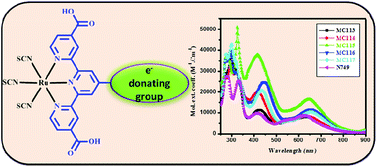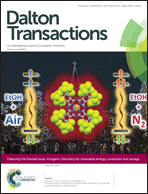Novel 4′-functionalized 4,4′′-dicarboxyterpyridine ligands for ruthenium complexes: near-IR sensitization in dye sensitized solar cells†
Abstract
Novel ruthenium complexes (MC113–MC117), obtained by modifying the terpyridine ligand of the black dye (N749), have been evaluated as sensitizers for dye sensitized solar cells (DSSCs). The modification is carried out by attaching selected chromophores, with varying electron donating strength, covalently to the central ring of the ligand. The complexes, compared to the parent dye, show red shifted absorption covering visible and near IR regions and higher molar extinction coefficients. We report in this work synthesis of a series of these ruthenium complexes with chromophores such as tert-butyl phenyl, triphenylamine, bithiophene, phenoxazine and phenothiazine. Detailed experimental characterization using optical, electrochemical and photovoltaic techniques has been carried out and complemented by density functional theory studies. The fill factors (ff) obtained for these dyes are larger than those of the parent black dye. In spite of these superior properties, the dyes show only moderate to good power conversion efficiencies. The possible reasons for this have been investigated and discussed.

- This article is part of the themed collection: Inorganic Chemistry for Renewable Energy Conversion and Storage

 Please wait while we load your content...
Please wait while we load your content...